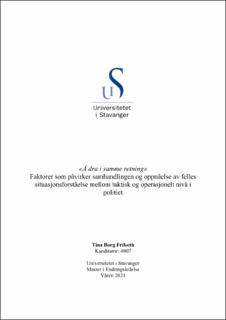| dc.contributor.advisor | Sunnercrantz, Liv Åsa-Maria | |
| dc.contributor.author | Frilseth, Tina Borg | |
| dc.date.accessioned | 2021-11-05T16:51:13Z | |
| dc.date.available | 2021-11-05T16:51:13Z | |
| dc.date.issued | 2021 | |
| dc.identifier | no.uis:inspera:83538997:47603899 | |
| dc.identifier.uri | https://hdl.handle.net/11250/2828218 | |
| dc.description.abstract | Denne oppgaven har til hensikt å belyse sentrale faktorer som påvirker samhandlingen og oppnåelse av felles situasjonsforståelse mellom lederne på taktisk og operasjonelt nivå i politiet. For å svare på min problemstilling har jeg valgt å intervjue innsatsledere og operasjonsledere i politiet. Jeg har i tillegg til dette gjennomført en dokumentanalyse av pensum som i dag blir brukt på utdannelsene; «funksjonsrettet ledelse for innsatsledere» og «funksjonsrettet ledelse for operasjons- og oppdragsledere» ved Politihøgskolen.
Resultatet av studien viser at innsats- og operasjonsledere i høy grad har forståelse for rolle- og ansvarsfordelingen, slik som PBS beskriver den. Det kommer frem at denne rolle- og ansvarsfordelingen i praksis er noe mindre rigid, noe som viser seg å av og til være hensiktsmessig. Dette kan tyde på at det effektiv samhandling utfordrer den fastsatte rolle- og ansvarsfordelingen. Dette gjelder spesielt opp mot presiseringen om at innsatsleder skal utføre de oppgaver han blir gitt av operasjonelt nivå. Også operasjonelt nivå sin støttefunksjon ovenfor taktisk nivå vil utfordre denne inndelingen. Studien viser at informantene synes samhandlingen har blitt bedre etter politireformen. Dette begrunnes med økt fokus på profesjonalisering av operasjonssentralen og faget innsatsledelse i distriktet. God samhandling og godt teamarbeid danner et grunnlag for en felles situasjonsforståelse. To av grunnpilarene i teamarbeid er felles målsetning og felles mentale modeller. Relasjoner, tillit og øvelser er faktorer som påvirker dynamikken i teamet i positiv retning og bør derfor vektlegges.
Oppnåelse av en felles situasjonsforståelse krever at innsats-og operasjonslederne er omforent om de kritiske faktorene ved hendelsen, målet med oppdraget og risikoen ved gjennomføring av oppdraget. Arbeidet videre innebærer å opprettholde denne felles forståelsen ved å ha kontinuerlig kommunikasjon med hverandre. Denne kommunikasjonen må være tydelig og av en slik art at misforståelser begrenses så mye som mulig. De bør derfor benyttes kjente begrep, kjente kommunikasjonsmønstre og bekreftende kommunikasjon. | |
| dc.description.abstract | This paper aims to shed light on key factors that affect the interaction and achievement of a shared situational awareness between the leaders at the tactical and operational command in the police. In this study I have chosen to interview incident commanders and operational commanders in the police. In addition to this, I have carried out an analysis of the syllabus that is currently used at the education of the incident- and operational leaders at the Police Academy.
The results of the study show that incident commanders and operational commanders to a large extent have an understanding of the division of roles and responsibilities. It emerges that this division of roles and responsibilities is in practice somewhat less rigid, which turns out to be sometimes appropriate. This may indicate that the effective collaboration challenges the established division of roles and responsibilities. This applies in particular to the clarification that the incident commanders must perform the tasks he is given by the operational command. The operational command's possibility to support the incident commander will also challenge this division. The study shows that the informants think the interaction has improved after the police reform. This is justified by an increased focus on the emergency dispatch center and the incident commander´s responsibility. Interaction and teamwork form a basis for a shared situational awareness. Two of the most important factors of teamwork is shared goals and shared mental models. Relationships, trust and training are factors that influence the dynamics of the team in a positive direction and should therefore be emphasized.
Achieving a shared situational awareness requires that the incident commander and operational commander agree on the critical factors in the incident, the goal of the assignment and the risk in carrying out the assignment. The work further involves maintaining this common understanding by having continuous communication with each other. This communication must be clear and of such a nature that misunderstandings are limited as much as possible. They should therefore use familiar concepts, familiar communication patterns and affirmative communication. | |
| dc.language | nob | |
| dc.publisher | uis | |
| dc.title | «Å dra i samme retning» - faktorer som påvirker samhandlingen og oppnåelse av felles situasjonsforståelse mellom taktisk og operasjonelt nivå i politiet | |
| dc.type | Master thesis | |
